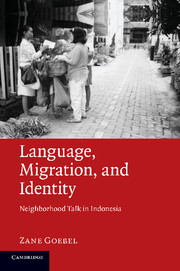Book contents
- Frontmatter
- Contents
- Figures
- Diagrams
- Maps
- Tables
- Extracts
- Preface
- Conventions
- 1 Introduction
- 2 Long-term Processes of Enregisterment
- 3 Enregistering Local Practices and Local Spaces
- 4 Linguistic Signs, Alternation, Crossing, and Adequation
- 5 Women, Narratives, Identity, and Expectations in Ward 8
- 6 Learning to Become a Good Ward Member
- 7 Emerging Identities in a Monthly Ward 8 Male Meeting
- 8 Chineseness as Deviance
- 9 Language Ideologies and Practice in Ward 5
- 10 Conclusions
- Notes
- References
- Index
9 - Language Ideologies and Practice in Ward 5
Published online by Cambridge University Press: 04 August 2010
- Frontmatter
- Contents
- Figures
- Diagrams
- Maps
- Tables
- Extracts
- Preface
- Conventions
- 1 Introduction
- 2 Long-term Processes of Enregisterment
- 3 Enregistering Local Practices and Local Spaces
- 4 Linguistic Signs, Alternation, Crossing, and Adequation
- 5 Women, Narratives, Identity, and Expectations in Ward 8
- 6 Learning to Become a Good Ward Member
- 7 Emerging Identities in a Monthly Ward 8 Male Meeting
- 8 Chineseness as Deviance
- 9 Language Ideologies and Practice in Ward 5
- 10 Conclusions
- Notes
- References
- Index
Summary
Introduction
A common thread in work on processes of semiotic register formation, enregisterment, and language ideology is that generally there is an imagined standard of linguistic conduct, which through various processes becomes tied to particular personas across time and space. As Inoue (2006), Agha (2003), and Errington (1998a, 2001), among others, have nicely pointed out, it is often an educated elite – whether university professors, religious leaders, bureaucrats, et cetera – who initiate such imaginings, and schools that help reify these language ideologies. Much of my discussion in Chapter 2 was devoted to this area as it relates to inter-ethnic relations and ethnicity, ethnic languages and Chineseness. In this chapter I want to sharpen my focus on two of these areas. The first relates to language ideologies about the use of Javanese intra-ethnically and the second relates to language ideologies about inter-ethnic interaction in Indonesia. In addressing these two issues I have two main aims. The first is to point to the differences between these language ideologies and situated practice. In line with the broader question that this book seeks to address, my second aim is to further explore how people go about establishing and maintaining social relations in settings characterized by diversity and transience.
Before doing so, however, I should start by pointing out what I mean by language ideology. Drawing upon the broad thrust of work on language ideologies and semiosis (e.g. Schieffelin, Woolard, & Kroskrity, 1998; Agha, 2007; Kroskrity, 2000; Agha, 2005), the way I will use the term language ideology here is as follows.
- Type
- Chapter
- Information
- Language, Migration, and IdentityNeighborhood Talk in Indonesia, pp. 172 - 190Publisher: Cambridge University PressPrint publication year: 2010



